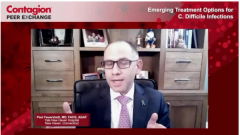
C. Difficile: Clinical Practice Guidelines and Treatment Options
Recommendations for treating C. difficile upon a first recurrence as well as following multiple recurrences based on currently available treatment options and recommendations by the IDSA/SHEA clinical practice guidelines.
Episodes in this series

Peter L. Salgo, MD: Let’s focus for a minute on some practice guidelines—you did mention guidelines—specifically for treating recurrent episodes of CDI [Clostridium difficile infection]. There are the IDSA [Infectious Diseases Society of America] and SHEA Clinical Practice Guidelines? Is it SHEA [Society for Healthcare Epidemiology of America]?
Dale N. Gerding, MD: Yeah, SHEA. SHEA it is.
Peter L. Salgo, MD: Got it. What are the recommendations for a first recurrence? Tom, could you walk us through that?
Thomas Lodise, PharmD, PhD: Yes. So if we’re talking about the 2008 guidelines, these are strength of evidence falling toward the weak to low side, either pulse dose, vancomycin [Vancocin], paper therapy, or fidaxomicin [Dificid]. We think about metronidazole, which was once in vogue. As a CDI treatment, it’s really fallen to the wayside. For first recurrence in the 2008 guidelines, those have risen to the top.
Peter L. Salgo, MD: Let me ask you, because I’ve been in this business awhile and I know metronidazole has always been pushed to the side, why? Did it not work? It seemed to work? What’s the problem?
Thomas Lodise, PharmD, PhD: It’s just be out performed across a number of studies. If you think about the drug, it probably doesn’t achieve high luminal concentrations relative to oral vancomycin or even fidaxomicin, and it’s a bit broad spectrum too. We’re going to get into a discussion on the microbiota. One of the things with CDI is the name of the game is targeted therapy, keeping a healthy bowel flora, and when you give a drug that takes away all your good bacteria, this is very problematic. The cure is actually part of the disease when we think about metronidazole for the treatment of CDI.
Peter L. Salgo, MD: What I understand you’re saying is that it’s so broad spectrum that it removes some of the protective milieu that actually keeps C diff in check. You can hammer the C diff, but there’s nothing else there it comes back. Is that what you’re saying?
Thomas Lodise, PharmD, PhD: That’s correct. There’s a grading effect too, and I know we’re going to talk a little about this later in the program. Even if we look at the fidaxomicin relative to vancomycin—both are potent CDI agents, but what we find with oral vancomycin is that it has high activity against Bacteroides and other good gut flora. Even with vancomycin as a targeted therapy against gram-positive organisms, relative to fidaxomicin, it’s even more too broad spectrum and many theorize that’s why you have the enhanced activity.
Paul Feuerstadt, MD, FACG, AGAF: Tom, I think that you bring up really important points, and I think the broad concept here is something called collateral damage, which is the targeted therapy versus less targeted therapy. Metronidazole and vancomycin [Vancocin]certainly were the original treatments of C difficile. Over time I think we’ve seen an evolution of higher recurrence rates to unacceptably high rates, and lower initial treatment responses. There was pivotal trial in 2014 that was designed to look at a product called tolevamer, which was an ion binder that didn’t actually work quite as well as it was expected. The 2 control groups within that study were vancomycin and metronidazole. It gave us prospective data comparing metronidazole and vancomycin on 500-plus patients. Vancomycin responded about 81.1% versus 72.7% with the metronidazole. This was a statistically significant difference and that study was conducted between 2005 and 2007. We believe that with time the initial treatment response and recurrence rates with metronidazole were inferior and became increasingly inferior. I think that’s what build up this concept on the clinical side. One basic treatment, metronidazole, is less targeted; therefore alters the microbiota and leads to higher risks for recurrence as well.
Peter L. Salgo, MD: Now that’s the first recurrence. What about multiple recurrences? How do all these recommendations change? Paul.
Paul Feuerstadt, MD, FACG, AGAF: With multiple recurrences there are several different options that they offer. Prolong vancomycin taper with or without a pulse at the end is 1 option. A standard vancomycin course for 10 days followed by a so-called rifaximin chaser, 550 mg orally, three times daily for 20 days also shows sufficient efficacy to be used in that space. If fidaxomicin [Dificid] hasn’t been used yet; 200 mg of fidaxomicin twice daily for 10 days is a consideration for a second recurrence and beyond.And then finally, entered the 2018 IDSA/SHEA [Infectious Diseases Society of America / Society for Healthcare Epidemiology of America] guidelines for individuals who received at least three antimicrobial courses, we consider microbiota replacement therapy or fecal microbiota transplantation.
Peter L. Salgo, MD: What was the year on that, on the guidelines?
Paul Feuerstadt, MD, FACG, AGAF: The 2018 guidelines is what we’ve been referring to. The 2010 guidelines were markedly different. We’ve seen the evolution based upon what I was discussing before with regards to the ineffectiveness of metronidazole. In the original 2010 guidelines for patients with non-severe infection, or mild-moderate infection as it was termed at that time, they recommended using metronidazole 500 mg 3x daily for 10 to 14 days. What decided nonsevere versus severe? White cell [white blood cell] count greater than 1500, or creatine greater than or equal to 1.5x the baseline. If either of those thresholds were met, vancomycin was recommended for initial treatment. But for first recurrence, it was recommended that we reuse the same antimicrobial. For second recurrence and beyond, that was where vancomycin taper was recommended. But as we said before, those guidelines are now dated. We can see that evolution largely removing metronidazole from the 2018 updated guidelines, favoring vancomycin or fidaxomicin first line for initial treatment, and fidaxomicin enters the conversation for recurrence as well.
Joseph Reilly, BS, PharmD, BCGP: If I could just add on, some people might just indiscriminately say, “Well, we’ll use a VANCO pulse taper therapy.” It’s demanding. We have to think about the patients we see who have C difficile; are they going to be adherent with taking vancomycin 4x a day for possibly 2 weeks, another 2x a day for a week, then 1x a day for another week, and then every 2 to 3 days for up to 8 weeks? That’s a demanding regimen that we have to put a patient on. I understand the efficacy behind it, but we shouldn’t approach that and just think, “Well, maybe I’ll use that.” If an alternative is available that might be easier and a patient might be compliant with, we have to consider it.
Peter L. Salgo, MD: We all know the study, right? The medical students who were given placebo for a year and asked to simply take one pill a day for a year. At the end of the year they counted the tabs that were remaining and it was huge. A motivated medical student taking a nontoxic drug, once a night. I mean 30% of the drug was unused; only 30% of it was placebo. This is, as Joe points out, not trivial. I’ll bet that the real compliance problem is not the 4x a day or the 2x a day, it’s the once every 3 days. That gets lost in the noise, doesn’t it?
Joseph Reilly, BS, PharmD, BCGP: That would probably be very difficult, especially considering the patient population. I would imagine that these patients would need help and they would have to be taking this for, as I said before, up to 8 weeks. And we know that adherence significantly drops off once we start getting past the 2x a day. You’re talking every 2 to 3 days, that could be very difficult as well.
Peter L. Salgo, MD: If you enjoyed this content, you should subscribe. We have an e-newsletter, and you can receive upcoming Peer Exchanges and other great content in your in-box—that’s right, electronically. I’ll see you next time. I’m Dr Peter Salgo. Thanks again for watching.
Newsletter
Stay ahead of emerging infectious disease threats with expert insights and breaking research. Subscribe now to get updates delivered straight to your inbox.



































































































































































































































































































